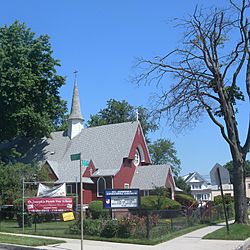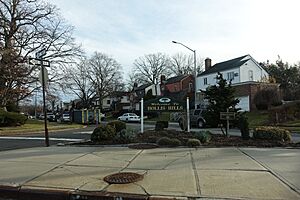Queens Village, Queens facts for kids
Quick facts for kids
Queens Village
|
|
|---|---|
|
Neighborhood of Queens
|
|

St. Joseph's Episcopal Church
|
|
| Country | |
| State | |
| City | New York City |
| County/Borough | Queens |
| Community District | Queens 13 |
| Population | |
| • Total | 52,504 |
| Ethnicity | |
| • Black | 50.2% |
| • Hispanic | 18.4% |
| • Asian | 16.0% |
| • White | 6.3% |
| • Other/Multiracial | 9.1% |
| Economics | |
| • Median income | $74,376 |
| Time zone | UTC−5 (EST) |
| • Summer (DST) | UTC−4 (EDT) |
| ZIP Codes |
11427, 11428, 11429
|
| Area codes | 718, 347, 929, and 917 |
Queens Village is a neighborhood in the eastern part of Queens, one of New York City's five boroughs. It is mostly a place where people live, with many homes and families.
This neighborhood is surrounded by other areas like Hollis to the west and Cambria Heights to the south. To the east, you'll find Bellerose, Queens and Elmont in Nassau County. Oakland Gardens is to the north.
You can find many shops and stores along streets like Braddock Avenue, Hillside Avenue, and Jamaica Avenue. Just outside Queens Village, in Elmont, is the famous Belmont Park race track.
Nearby, there are large parks like Cunningham Park and Alley Pond Park. There's also the historic Long Island Motor Parkway (LIMP), which was once used for car races. Today, it's part of a green path for walking and biking called the Brooklyn-Queens Greenway.
Queens Village is part of Queens Community District 13. Its main postal codes are 11427, 11428, and 11429. The local police station is the 105th Precinct of the New York City Police Department.
Contents
History of Queens Village
Queens Village started as a small settlement called Little Plains in the 1640s. You can still see a nod to this old name at the Long Island Railroad Station.
In 1824, a man named Thomas Brush opened a blacksmith shop here. His business grew, and soon the area became known as Brushville. The railroad arrived in 1837, and the train station's name changed a few times, including Flushing Avenue and Delancy Avenue, before also being called Brushville.
In 1856, the people living there voted to change the name from Brushville to Queens. For a while in the 1860s and 1870s, the name "Inglewood" was also used for the village and the train station.
When the Borough of Queens became part of New York City in 1898, and Nassau County was created in 1899, the border between the city and Nassau County was set just east of Queens Village. To avoid confusion with Queens County, the Long Island Railroad added "Village" to its station's name in 1923. That's how the neighborhood officially became known as Queens Village.
In the 1920s and 1930s, many people from New York City moved to Queens Village. They were looking for a quieter life away from the busy city. Many of the beautiful homes built then, like Dutch Colonial and Tudor styles, are still here today and attract many different kinds of people.
Other Queens Village on Long Island
There was another place called Queens Village on Long Island, in what is now Suffolk County. It was known by that name from 1685 until the late 1800s. Later, it became known as Lloyd Neck and joined Suffolk County.
Neighborhood Sections
Bellaire
Bellaire is a part of western Queens Village, located next to Hollis. It covers the area around Jamaica Avenue and 211th Street. Bellaire is the largest section within Queens Village. Most people just call this area Queens Village. There used to be a train station here called Bellaire.
Hollis Hills
Hollis Hills is a well-off part of Queens Village. It is generally bordered by Springfield Boulevard to the east and Grand Central Parkway to the south. This area is a bit higher than sea level because of a glacier from the last Ice Age. There's a small pond called Potamogeton Pond near Bell Boulevard.
Most homes in Hollis Hills are built in Colonial, Tudor, and Ranch styles. These houses are often quite expensive and attract many upper-middle-class families. The neighborhood feels a bit like a suburb, with large detached homes and lots of trees. Surrey Estates is a smaller part of Hollis Hills known for its special homes and old, big trees.
Important places in Hollis Hills include churches, a Jewish center, a Catholic church, and the Windsor Park Branch of the Queens Public Library. There are also schools like Kingsbury Elementary School (P.S. 188) and local community groups.
People of Queens Village
Queens Village is a very diverse neighborhood, much like many other parts of Queens. Many people here are of Caribbean American background. There are also many people from Guyana, Hispanic and Latino backgrounds, India, the Philippines, and Jamaica.
In the past, there was a large Jewish community here. While many Jewish families have moved to other parts of Queens or Long Island, a small Jewish presence remains. Recently, more Jewish people from the Middle East have moved to the area. There has also been an increase in the number of Asian American residents.
According to the 2010 United States Census, about 52,504 people lived in Queens Village. The neighborhood is made up of different groups:
- About 50% are African American.
- About 16% are Asian.
- About 6% are White.
- About 18% are Hispanic or Latino.
The average life expectancy in this area is about 82.9 years, which is higher than the average for New York City. Most people living here are young or middle-aged adults.
In 2017, the average household income in this area was about $85,857. Only about 13% of Queens Village residents live in poverty, which is lower than the average for Queens and New York City. This means that Queens Village is considered a high-income area compared to the rest of the city.
Fire Safety
Queens Village has its own New York City Fire Department (FDNY) fire station. It is called Engine Co. 304/Ladder Co. 162 and is located at 218–44 97th Avenue.
Post Offices and ZIP Codes
Queens Village uses three different ZIP Codes:
- 11427 for the northern part (north of 90th Avenue).
- 11428 for the middle part (between 90th and 99th Avenues).
- 11429 for the southern part (between 99th and 114th Avenues).
The United States Post Office has a branch nearby called the Queens Village Station at 209–20 Jamaica Avenue.
Education
Queens Village has a good education system. About 38% of adults aged 25 and older have a college degree or higher. This is similar to the rest of New York City.
The percentage of elementary school students who miss a lot of school days is lower in Queens Village than in other parts of New York City. Also, about 83% of high school students in Queens Village graduate on time, which is higher than the city average.
Schools in Queens Village
Public schools in Queens Village are run by the New York City Department of Education. Some of these schools include:
- P.S. 018 The Winchester School
- P.S./I.S. 295
- P.S. 33 Edward M Funk School
- P.S. 95 Eastwood School
- I.S. 109 Jean Nuzzi Intermediate School
- M.S 172 Irwin Altman
- Queens Gateway to Health Sciences Secondary School
- P.S. 034 John Harvard School
- P.S. 135 The Bellaire School
- P.S.188
- Martin Van Buren High School
There are also several private schools, such as Saints Joachim and Anne School and St. Joseph's Episcopal Day School.
Library
The Queens Public Library has a branch in Queens Village. It is located at 94–11 217th Street.
Transportation
The Queens Village train station is on Amboy Lane, near Springfield Boulevard and Jamaica Avenue. You can catch the Long Island Rail Road's Hempstead Branch trains here.
While there are no New York City Subway stations directly in Queens Village, many bus routes connect the neighborhood to subway lines. These include several MTA Regional Bus Operations routes like the Q1, Q2, Q27, Q36, Q43, Q77, Q83, Q88, and Q110. There are also Nassau Inter-County Express (NICE) bus routes. An express bus, the X68, goes directly to Manhattan.
Long-distance buses from companies like Greyhound, Short Line, and Adirondack Trailways also stop near Hillside Avenue and Springfield Boulevard.
Famous People from Queens Village
Many notable people have lived in Queens Village, including:
- Chy Davidson (born 1959), a former professional football player for the New York Jets.
- George Gately (1928–2001), who created the Heathcliff comic strip.
- Karine Jean-Pierre (born 1974), who became the White House Press Secretary in 2022.
- Paul Newman (1925–2008), a famous actor who lived here for a short time.
- Roy Wilkins (1901–1981), an important leader in the civil rights movement.
See also
 In Spanish: Queens Village (Queens) para niños
In Spanish: Queens Village (Queens) para niños



